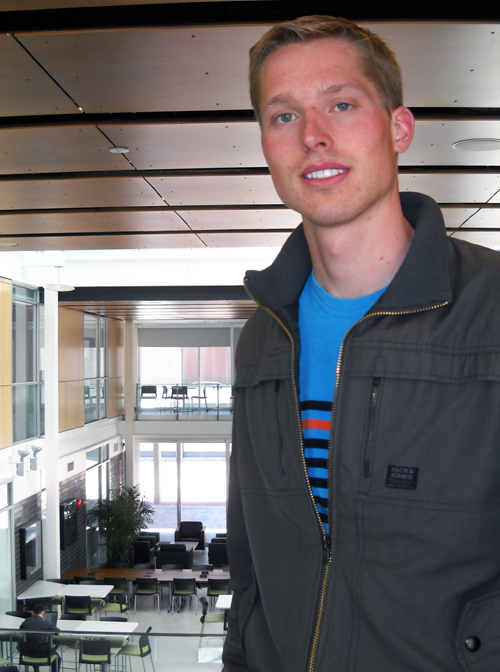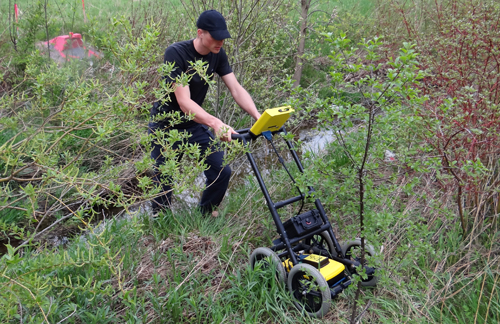
As a “fugitive” from the law, Andrew Pronk had fled into the woods near Borden, Ont., after dark. He went a few kilometres before burrowing down beside a fallen log. Soon enough, he heard the sounds: barking first, then the crackling of brush, nearer and nearer.
Then the German shepherd and its police handler team were on him.
Blinded by a handful of lights mounted on assault rifles, Pronk obeyed the terse commands: “Turn around. On your knees. Hands behind your head.”
A moment later, the drill was done, with success on both sides. The police dog and its handler team from the Ontario Provincial Police (OPP) had gotten some tracking practice, and Pronk had survived his first-ever outing as a “quarry.”
Today, he’s also survived five years in the co-op stream of his environmental engineering program at U of G. Now, he starts a full-time job that will bring together his study interests in an emerging search and rescue technology with his nearly 10 years’ worth of volunteering with the OPP.
Pronk started working full-time this month at Sensors and Software Inc., based in Mississauga, Ont.
As a student, he spent three co-op work terms helping to develop the company’s forensic ground-penetrating radar (GPR) system. Now as a product specialist, he will train users – including police officers — in the technology.
Industry uses GPR to detect buried objects from storage tanks to soil water. Police forces are eyeing the technology for help in locating other things, including bodies, weapons, caches of drugs or money, or evidence of site disturbance.
Although some Canadian forces have begun using GPR, it’s still new to law enforcement, says Mike Dolderman. He’s a sergeant with the OPP’s urban search and rescue response team located in Bolton, Ont.

Last year, that unit used ground-penetrating radar to hunt for remains of Laura Babcock, who police believe was killed two years ago. Dellen Millard, accused in the 2013 death of Ancaster’s Tim Bosma, is also alleged to have killed Babcock.
Explaining that some police forces might hire private companies to conduct a GPR search, Dolderman says, “We’re the only policing agency I know in Canada that operates this.”
To do that, they’ve relied partly on the U of G engineering student.
Using what he’d learned during his co-op terms and through his volunteer connections with the police force, Pronk helped the unit write operating procedures and training standards for using ground-penetrating radar.
During a one-week course last fall, he taught GPR to an inaugural class of about eight officers, and he expects to lead future classes.
Dolderman says those protocols – established in 2012 and 2013 — were “developed mostly for the OPP with Andrew Pronk’s help. He has technical expertise through his training both in his co-op and his scholastic training at U of G.”
Pronk has used the technology himself in the field.
In one case, he worked with OPP officers to search for an abandoned well on a farm where police thought a body had been buried decades earlier. By the time the team investigated the site, any sign of a well had vanished. Even the former farmhouse had been razed years earlier.
Resembling a lawnmower, the GPR unit contains equipment for emitting radar and receiving signals from underground. The operator reads results on a screen on the handle while pacing out a grid pattern.
The team crisscrossed the property with the GPR device. They detected the buried foundation of the house and then the well – but no body.
“That’s a good outcome,” says Pronk. Yes, the case remains cold. But he says the police can rule out that site and look in other places.
In 2011, he helped set up an OPP site at Bolton complete with buried items for testing GPR and related technologies. Says Dolderman: “A lot of this stuff has been driven by Andrew. These will be good case studies for ages to come to show how GPR is affected by conditions and decomposition rates.”
Pronk’s ties with law enforcement go back to 2006. Before coming to U of G, he had considered a policing career.
Originally from Fergus, Ont., he began volunteering that year with the OPP canine unit. His first-ever stint was that night-time quarrying exercise in Borden. “I’m always interested in trying new things.”
Recalling the simulated take-down, he says, “It felt almost surreal. You’re never aware you’re going to be in that situation, being tracked by dogs in the dark.”
He’s repeated that exercise about a dozen times since.
In another canine training scenario, he has played a passive victim of a building collapse. Here, Pronk tucks his 6-foot-4 frame inside a cavity in a specially constructed rubble pile and waits for dogs – Labrador retrievers this time, he says, the olfactory champions of the canine world – to sniff him out for rescuers.
He joined the OPP auxiliary force three years ago. Auxiliary members volunteer alongside regular officers, including at events such as the Fergus Scottish Festival. Pronk now trains for four hours a month and volunteers for 12 hours.
Andrew’s dad, Irwin, B.Sc. ’81, studied food science at Guelph and is now a food safety consultant.
Andrew recalls the time they spotted chemistry professor Joe Prokipcak in Fergus. He said, “Hey, that’s my chemistry professor, Dad.”
Irwin’s response: “No way, that was my chemistry professor, too.”
Andrew’s mom, Joanne Steinlin, completed a BA at U of G in 1985.